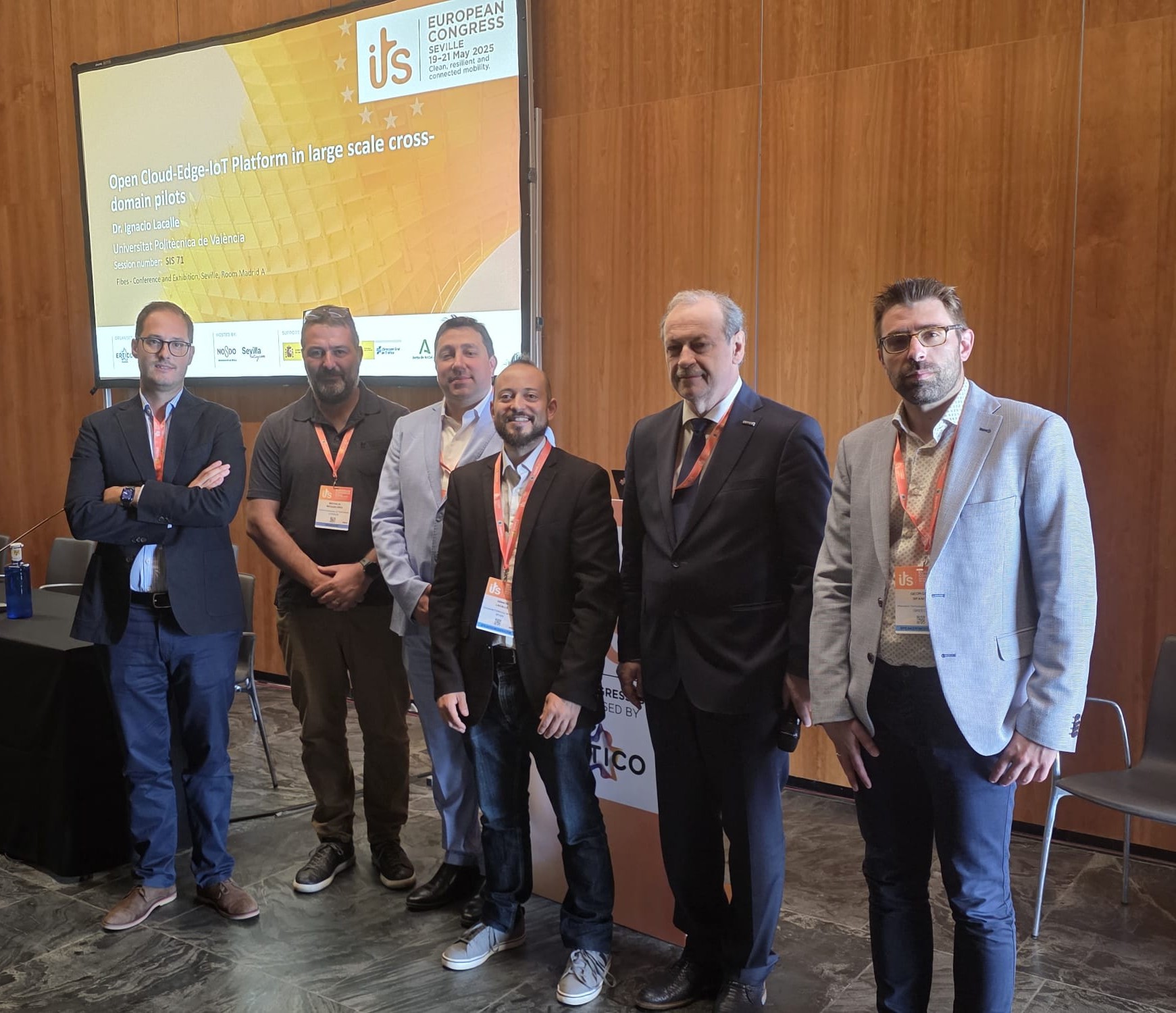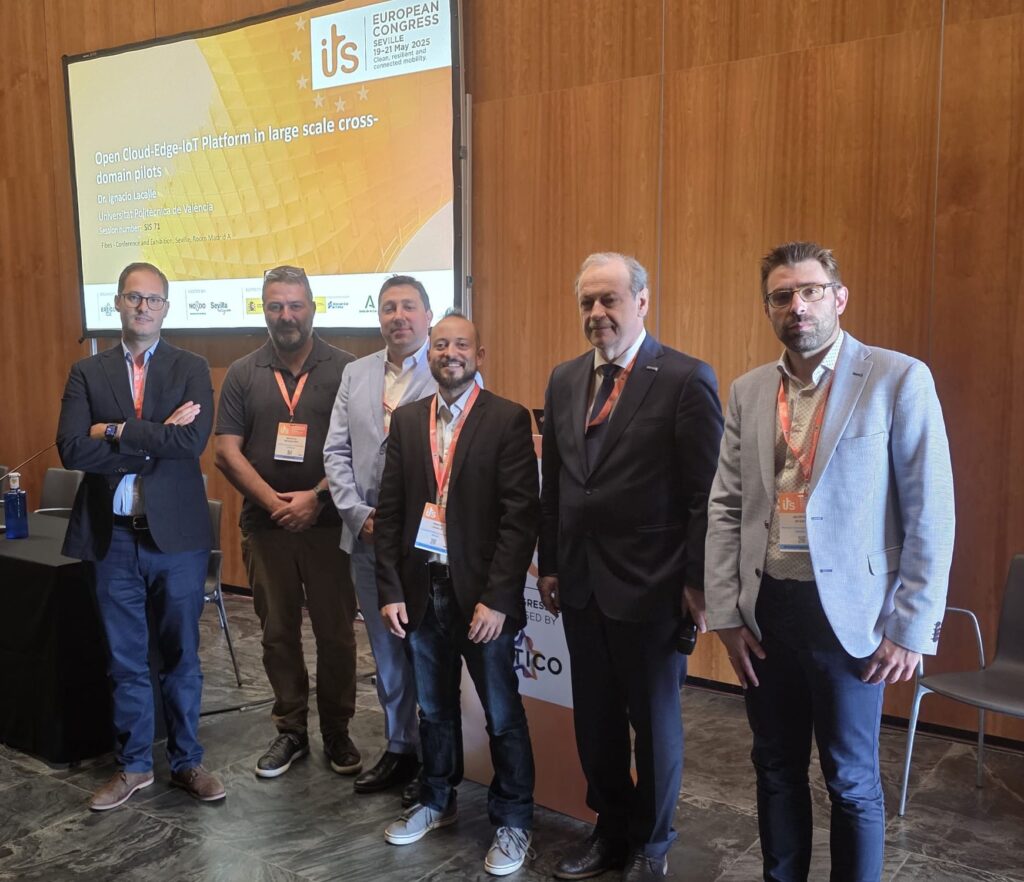At the 2025 ITS European Congress, the O-CEI project took centre stage during Special Interest Session (SIS) 71, highlighting its real-world impact in transforming the future of transportation and energy management through Cloud-Edge-IoT (CEI) technologies. The session, organized by Dr. Eugeniu Catana, from ERTICO, brought together key project partners and industry experts to explore how digital innovation, AI, and cybersecurity are enabling smarter, more sustainable mobility systems.
Many transport and logistics companies – from ports to EV charging providers – face a common problem: they collect a lot of useful data, but often can’t use it fast enough to make quick decisions. Their machines and systems are controlled by basic software that can’t do much more than follow set instructions. While some are starting to use tools like AI, big data, and IoT, these are usually connected to remote servers or cloud platforms, which means there’s a delay between when the data is created and when it can be used. This delay makes it harder for companies to act quickly and efficiently. The O-CEI project is helping to solve this problem by bringing the intelligence closer to where the action happens — at the “edge” of the network. Using tools like the aerOS Meta Operating System, O-CEI helps manage and coordinate smart services locally, so that companies can make faster, better decisions right when and where they need to.
The main focus of the session was to highlight how emerging technologies and data sharing can make transportation systems more intelligent, interconnected, and energy efficient. Speakers presented concrete pilot cases across Europe, showcasing how O-CEI supports everything from vehicle-to-cloud services to port energy orchestration. This enforced the message that smart mobility isn’t a concept for the future; it’s already being implemented across Europe’s infrastructure.
Several leading voices in the O-CEI consortium shared insights.
-
- Igancio Lacalle Ubeda, from Politechnical University of Valencia, the institution coordinating the O-CEI project, moderated the session, providing structure and industry context throughout the session
-
- Mihail Gaianu, Continental Automotive Romania, presented the Pilot 2
-
- Eduardo Garro, Prodevelop SL, introduce the Pilot 6
-
- George Spanos, CERTH, presented the Pilot 7
O-CEI as backbone for Vehicle-as-a-Service
Mihail Gaianu (Continental Romania) presented how the O-CEI project supports the concept of Vehicle as a Service (VaS), using Timisoara as a site for the Pilot 2. He introduced three interconnected projects that are shaping the future of smart, secure, and efficient mobility.
The first project, XRECO, focuses on enhancing the travel experience through an AI-powered navigation and information system. This next-generation platform builds on traditional GPS by adding intelligent features that help drivers discover and explore new destinations, making travel more intuitive and informative.
The second project, SMARTY, highlights the growing importance of cybersecurity in connected vehicles. With technologies like Vehicle-to-Everything (V2X) communication and Advanced Driver Assistance Systems (ADAS) becoming more common, ensuring the security of onboard electronics is critical. Continental’s role is to protect these systems from unauthorized access and cyber threats, supporting safe and resilient mobility.
The O-CEI Pilot 2 is advancing the VaS platform by integrating high-performance computing and intelligent energy management. The goal is to improve both the performance and energy efficiency of vehicles, especially in shared, autonomous, or subscription-based mobility models. A practical example was given from Sevilla, the city that hosted the ITS-ERTICO Congress. In Sevilla, high temperatures lead to increased air conditioning use, causing faster battery drain. In this case, the system must not only find the nearest charging station but also factor in real-time traffic data to estimate how long it will take to get there, ensuring the journey remains smooth and efficient.
Together, these projects show how O-CEI and its partners are laying the groundwork for a new era of smarter, greener, and more secure vehicle services.
O-CEI in the Maritime Sector: Making Malta a Model Smart Port
Eduardo Garro presented the O-CEI maritime pilot (Pilot 4), set in Malta’s Freeport Terminal, one of the Mediterranean’s largest transshipment hubs.
This O-CEI pilot is structured across three scenarios:
-
- Vessel Energy Management: Real-time orchestration of energy storage, visualisation tools, and cybersecurity layers ensure minimal disruptions and blackout prevention during operations.
-
- Terminal Energy Management: O-CEI coordinates energy usage across terminal assets, setting operational priorities for vessel servicing and infrastructure.
-
- Residential Energy Management: Involving local homes connected to the grid of the port, this scenario tests governance models and secure, priority-based reconnection protocols during energy surges.
With support from Enemalta, Malta Freeport Terminal, Schneider Electric, Prodevelop, and Awake.AI, this pilot is positioning Malta as a leading example of CEI-powered port decarbonisation in Europe.
The Malta pilot highlights how digitalisation and the orchestration capabilities of the O-CEI project can support ports in reducing congestion and emissions, optimising energy use, and integrating cleaner energy sources. By applying smart control systems and edge computing, the pilot offers a practical path forward for modernising port infrastructure. Its successful implementation could position Malta as a leader in fostering close collaboration between municipalities, port operators, and technology providers to achieve more sustainable and efficient port operations.
Cognitive EV Charging: Smart, Private, and Secure
George Spanos from CERTH rounded out the session with insights from the O-CEI Pilot 7, built around EV charging optimisation and cybersecurity, taking place in Lombardy, Italy, a region with over 60,000 EV recharges.
In this pilot, vehicles are equipped to make intelligent, data-driven decisions about where and when to charge. This dynamic approach helps reduce energy waste, manage demand more efficiently, and ultimately supports more sustainable travel.
However, introducing this level of intelligence also brings new security and privacy risks. The team identified key concerns such as unprotected communication, potential hacking, attacks on AI models, denial-of-service incidents, and threats from malicious software updates. Privacy risks are equally pressing, including tracking user locations, profiling energy use, and exposing personal data; all made worse by the limited control users currently have over their own data.
To address these issues, the pilot integrates a set of security tools: real-time network monitoring, lightweight anomaly detection systems, and AI-based intrusion detection using deep learning. Privacy is also reinforced through the use of distributed ledger technologies (DLTs).
With partners like NOVA, CERTH, ARES, and EGAP, the pilot aims to deliver a safer and smarter EV charging experience, with potential for future expansion beyond Italy into regions like Greece.
Why It Matters
The O-CEI session at the ITS European Congress showcased how real-world pilots across Europe are actively addressing today’s complex mobility and energy challenges and how edge intelligence and orchestration can unlock efficiency, sustainability, and resilience across the transport ecosystem.
These pilots highlight the strength of the O-CEI approach: connecting heterogeneous assets, ensuring secure data exchange, and enabling real-time decisions at the edge. This aligns closely with O-CEI’s broader mission, to build a sustainable and resilient Cloud-Edge-IoT (CEI) ecosystem, fostering a smoother transition towards a cleaner energy future.
As Europe moves toward climate neutrality and smarter infrastructure, the work being done through O-CEI provides a clear path forward, one where digitalisation is not just a tool but a driver of real, measurable impact.



